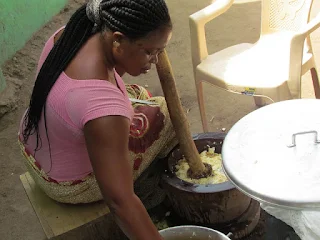African Cuisine Platter: Build the Perfect Charcuterie Board
Discover the magic of African cuisine with this essential charcuterie board guide. Learn how to create a stunning and flavorful platter featuring simple yet delicious African dishes. This African food charcuterie board will be amazing because it contains good simple food and explanations for each dish across the African continent. Simply follow the 3,3,3,3 rule, stick to three kinds of cheese, three types of meat, three starches, and three accouterments.
African Food Charcuterie Board Ideas
Here's a curated selection of foods for your stunning African food platter:
 |
| African Food Charcuterie Board |
African Charcuterie Board Meats
Biltong is not beef jerky; it is a dried and cured meat snack popular in South Africa, Namibia, and Zimbabwe. It is typically made from beef, game, or ostrich meat.
Droëwors are dried sausages from South Africa, made from beef or game meat and flavored with coriander seeds.
Suya is a famous Nigerian skewered meat, usually beef or chicken.
 |
| African Food Charcuterie Board |
African Cuisine Platter Cheese Selections
Lebna is a type of strained yogurt cheese, thick and spreadable, commonly found in countries like Egypt and Libya.
Ayibe is an Ethiopian fresh cheese, mild and crumbly, often used in salads.
Wara is a West African cheese made from cow's milk or soymilk, similar to tofu in texture.
Breads and Crackers
Fufu is rolled into golf ball-sized balls, an indentation is made with the right finger and then dipped into a soup, sauce, or stew to soak up the flavor.
Chapati is a flatbread from East Africa, perfect for wrapping or dipping.
Injera is an Ethiopian and Eritrean sourdough flatbread, spongy in texture, used to scoop up other foods.
Khobz is a Moroccan round bread, slightly crusty and perfect for spreading or dipping.
Funge is a traditional and authentic side dish commonly served with classic Angolan stews, but you can dip your funge in a spicy dip.
 |
| Making fufu |
Fruits and Nuts
Kola Nuts are a cherished and revered ancient nut plant that is culturally very important for West and Central tribes in traditional ceremonies, special events, and welcoming visitors. Kola nut has natural sweetness as well as lots of caffeine.
Baobab Fruit, either dried or as a powder, is known for its tangy flavor and high nutritional value.
Tiger Nuts or Chufa is a traditional snack in West Africa, chewy and slightly sweet.
Umkhiwa salted figs with honey is a fruit popular on African food charcuterie boards.
Greens and Herbs
Black-eyed pea leaves have a tender texture and a mild, slightly sweet flavor.
Raw sorrel is a leafy green herb with a tangy, lemon-like flavor. Blueberry farmers are familiar with the plant because it thrives in the same conditions under which blueberries are cultivated.
Young okra is delicious raw. Young tender okra is soft and ideal for eating raw or cooked, while large old okra is tougher and more fibrous.
Spreads and Dips
Harissa is a spicy Tunisian chili paste, great for adding a kick to meats and pieces of bread.
Peanut Sauce is common in West African cuisine, rich and savory, perfect for dipping meats or breads.
Zaalouk is a Moroccan eggplant and tomato dip, flavorful and slightly smoky.
African Pickled and Preserved Items
Atchar is a South African pickled relish, usually made from green mangoes.
Chakalaka is a South African vegetable relish that is spicy and tangy and often served cold.
Pickled Lemons are common in North African cuisine, adding a tangy, citrusy note.
 |
| Banana Beer |
African Cuisine Platter Sweets
Koeksisters is a South African sweet, syrup-coated doughnut that is sticky and delicious.
Sesame Brittle, also known as Nougat, is crunchy and sweet, popular in many African regions.
Coconut candies are sweet and chewy and are enjoyed in coastal parts of Africa.
African Food Charcuterie Board Beverages
Madila from Botswana is a traditional fermented milk product, thick and similar to yogurt cheese, used in various dishes.
Rooibos Tea is a South African herbal tea that is naturally sweet and caffeine-free.
Hibiscus Tea, also known as Bissap, is popular in West Africa, tart and refreshing, often served cold.
Rwanda is famous for Urwagwa or Banana-beer served in traditional containers. Urwagwa is a local Rwanda banana beer brew made out of crushed banana nectar.
Ginger Beer is a famous African drink with spicy and sweet notes. This non-alcoholic beverage is common in nearly every African country.
Palm Wine is perhaps the most time-honored and universal moonshine in Africa. Palm wine or white drink is an alcoholic beverage widely consumed in West, South, and Central Africa. People of Africa have for centuries tapped the sap found in palm trees and let it ferment to make a popular alcoholic beverage created from the sap of various species of palm trees.





